
Hockey is a term used to denote a family of various types of both summer and winter team sports which originated on either an outdoor field, sheet of ice, or dry floor such as in a gymnasium. While these sports vary in specific rules, numbers of players, apparel, and playing surface, they share broad characteristics of two opposing teams using a stick to propel a ball or disk into a goal.

Ice hockey is a team sport played on ice skates, usually on an ice skating rink with lines and markings specific to the sport. It belongs to a family of sports called hockey. In ice hockey, two opposing teams use ice hockey sticks to control, advance, and shoot a closed, vulcanized, rubber disc called a "puck" into the other team's goal. Each goal is worth one point. The team which scores the most goals is declared the winner. In a formal game, each team has six skaters on the ice at a time, barring any penalties, one of whom is the goaltender. Ice hockey is a full contact sport, and is considered to be one of the more physically demanding team sports. It is distinct from field hockey, in which players move a ball around a non-frozen pitch using field hockey sticks.
Roller hockey is a form of hockey played on a dry surface using wheeled skates. It can be played with traditional roller skates or with inline skates and use either a ball or puck. Combined, roller hockey is played in nearly 60 countries worldwide.

In many team sports, defense or defence is the action of preventing an opponent from scoring. The term may also refer to the tactics involved in defense, or a sub-team whose primary responsibility is defense. Similarly, a defense player or defender is a player who is generally charged with preventing the other team's forwards from being able to bear down directly on their own team's goalkeeper or goaltender. Such positions exist in association football, ice hockey, water polo and many other sports.

An ice hockey rink is an ice rink that is specifically designed for ice hockey, a competitive team sport. Alternatively it is used for other sports such as broomball, ringette, rinkball, and rink bandy. It is a rectangle with rounded corners and surrounded by walls approximately 1.22 metres (48 in) high called the boards.

A face-off is the method used to begin and restart play after goals in some sports using sticks, primarily ice hockey, bandy, floorball, broomball, rinkball, and lacrosse.

A goaltender mask, commonly referred to as a goalie mask, is a mask worn by goaltenders in a variety of sports to protect the head and face from injury from the ball or puck, as they constantly face incoming shots on goal. Some sports requiring their use include ice hockey, lacrosse, inline hockey, field hockey, rink hockey, ringette, bandy, rinkball, broomball, and floorball. This article deals chiefly with the goal masks used in ice hockey.
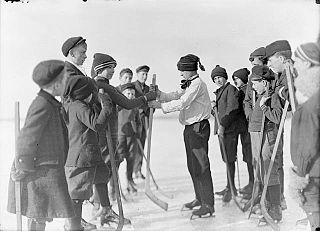
Shinny is an informal type of hockey played on ice. It is also used as another term for street hockey. There are no formal rules or specific positions, and often, there are no goaltenders. The goal areas at each end may be marked by nets, or simply by objects, such as stones or blocks of snow. Body checking and lifting or "roofing/reefing/raising the puck" are often forbidden because the players are not wearing protective equipment. Shinny is a game that all levels of hockey enthusiasts can play because it requires no rink, requires no skills except ability to hold a stick and at the very least to try to touch the puck or ball when it goes by. Shinny may be completely non-competitive and recreational.
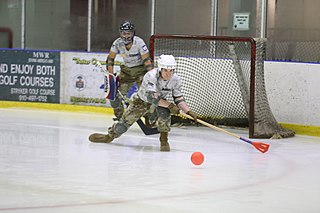
Broomball is a both a recreational and organized competitive winter team sport played on ice or snow and is played either indoors or outdoors, depending on climate and location. It is a ball sport and is most popularly played in Canada and the United States.
The Amateur Hockey Association of Canada (AHAC) was an amateur men's ice hockey league founded on 8 December 1886, in existence until 1898. It was the second ice hockey league organized in Canada, after one in Kingston, Ontario started in 1883. It was organized to provide a longer season to determine the Canadian champion. Prior to its founding, the Canadian championship was determined in a tournament in Montreal. It is the first championship ice hockey league.
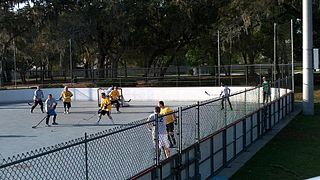
Street hockey is a collection of team sport variants played outdoors either on foot or with wheeled skates, using either a ball or puck designed for play on flat, dry surfaces. The object of every game is to score more goals than the opposing team by shooting the ball or puck into the opposing team's net. All games are derivatives of either the sport of ice hockey, floor hockey, bandy, and/or field hockey.

An ice rink is a frozen body of water and/or an artificial sheet of ice where people can ice skate or play winter sports. Ice rinks are also used for exhibitions, contests and ice shows. The growth and increasing popularity of ice skating during the 1800s marked a rise in the deliberate construction of ice rinks in numerous areas of the world.

Floor hockey is a broad term for several indoor floor game codes which involve two teams using a stick and type of ball or disk. Disks are either open or closed but both designs are usually referred to as "pucks". These games are played either on foot or with wheeled skates. Variants typically reflect the style of ice hockey, field hockey, bandy or some other combination of sport. Games are commonly known by various names including cosom hockey, ball hockey, floorball, or simply floor hockey.

Roller in-line hockey, American roller hockey or inline hockey, is a variant of hockey played on a hard, smooth surface, with players using inline skates to move and ice hockey sticks to shoot a hard, plastic puck into their opponent's goal to score points. The sport is a very fast-paced and free-flowing game and is considered a contact sport, but body checking is prohibited. There are five players including the goalkeeper from each team on the rink at a time, while teams normally consist of 16 players. There are professional leagues, one of which is the National Roller Hockey League (NRHL). While it is not a contact sport, there are exceptions, i.e. the NRHL involves fighting.
Spongee or sponge hockey is a winter sport and a variant of ice hockey that is played on outdoor ice rinks without ice hockey skates. It is played almost exclusively in Winnipeg, Manitoba, Canada, and has been played by thousands of players in dozens of leagues. The sport takes its name from the type of puck used, which is soft sponge puck as opposed to the hard vulcanized rubber puck used in traditional ice hockey.
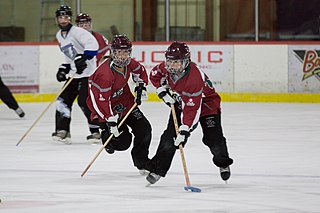
Ringette is a non-contact winter team sport played on an ice rink using ice hockey skates, straight sticks with drag-tips, and a blue, rubber, pneumatic ring designed for use on ice surfaces. While the sport was originally created exclusively for female competitors, it has expanded to now include participants of all gender identities. Although ringette looks ice hockey-like and is played on ice hockey rinks, the sport has its own lines and markings, and its offensive and defensive play bear a closer resemblance to lacrosse or basketball.
Ice hockey is believed to have evolved from simple stick and ball games played in the 18th and 19th centuries in Britain, Ireland, and elsewhere, primarily bandy, hurling, and shinty. The North American sport of lacrosse was also influential. These games were brought to North America and several similar winter games using informal rules developed, such as shinny and ice polo, but were later absorbed into a new organized game with codified rules which today is ice hockey.
The origin of ice hockey was bandy, a game that has its roots in the Middle Ages. Just as for practically all other sports, the game of bandy achieved its modern form during the 19th century in England, more exactly in the Fen district on the East coast. From the Fen district the game was spread to London and from London to the Continent during the second half of the 19th century. British soldiers stationed in eastern Canada brought the game to the North American continent in the 1850s and '60s. You could find similar games there, played by immigrants and by Indians. Thus there were a number of different games played on skates with a stick and ball and with varying rules in America before ice hockey was invented.
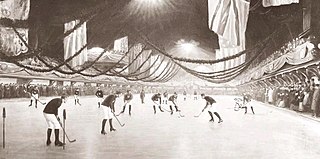
On March 3, 1875, the first recorded indoor ice hockey game took place at the Victoria Skating Rink in Montreal, Quebec. Organized by James Creighton, who captained one of the teams, the game was between two nine-member teams, using a rubber "puck". Members used skates and sticks used for outdoor hockey and shinny games in Nova Scotia, where Creighton was born and raised. It is recognized as the first organized ice hockey game.
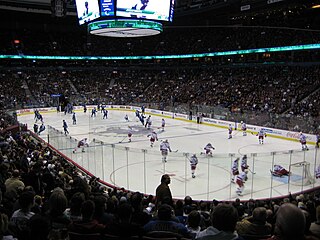
An ice hockey arena is a sport venue in which an ice hockey competition is held. Alternatively it is used for other sports such as broomball, ringette and rink bandy.



















